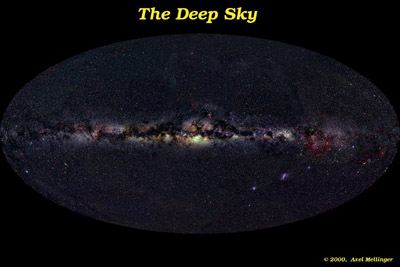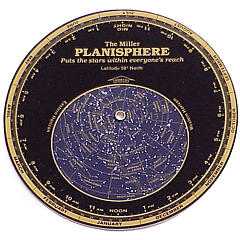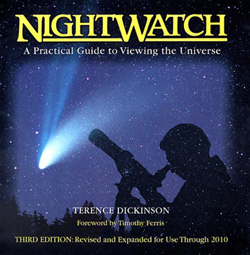Viewing the night sky
To learn your way around the night sky you do not need anything more than your eyes, a reasonably clear dark sky and something to tell you what you can see.
Your eyes
They are a truely wonderful device, but you can learn to get the best out of them! First of all you will be aware that the eye's iris controls the amount of light entering them. As it gets darker, the iris opens up to let in more light, but it takes perhaps 15 minutes for it to fully open when one goes out into a dark night - so give yourself time! Bright lights can quickly cause them to close again so avoid passing cars and if you use a torch (as you will need to) cover the lens with red paper or plastic to give a very low light level. You will also find that if you stay out for upwards of an hour or so you will be able to see even more as the rods in your retinas get more efficient.
Keep Warm!
On cold clear nights the temperature drops rapidly so you will need to keep warm. Wearing several layers of clothing is better than one very thick coat and look after your feet - thick socks in boots work well - and head - a nice wooly hat is excellent.
What will you be able to see
The first obvious things are the star patterns - called constellations. Then there are some star clusters such as the Pleiades and even a distant galaxy, the Andromeda Nebula. Perhaps surprisingly, its often best to start when the sky is not too clear so that only the brighter stars are visible. It is then much easier to make out the constellation shapes. When the sky is very clear and totally dark the brighter stars seem to get lost amongst the myriads visible!
Against the starry backdrop you will be able to observe the brighter planets too and, of course, the Moon.
How will I know what to look for?
Not all stars are visible each night but there are some stars called circumpolar stars which can be seen in the North every night. Apart from these, different stars become visible during the nighttime hours as the Earth moves around the Sun in its orbit during the year. So you need to have a star chart correct for the time of year AND the time at which you observe. It is important that the star chart is appropriate for the latitude at which you are observing - in the UK around 51 degrees north, in the USA 40 degrees north, in South Africa and Australia around 30-35 degrees south.
One way to get a monthly star chart is to buy one of the Astronomy Magazines such as Sky and Telescope and Astronomy, both published in the USA, and Astronomy Now published in the UK. These have the advantage that they show you the positions of the planets too, but they tend only to be useful in the evening hours.
A totally general star chart is provided by a Planisphere and one of these should be your first purchase. Make sure that it is correct for your latitude!
A planisphere has two parts:
- the lower is a map of all the sky that can, at some time, be seen from the latitude for which it is designed. Around its edge are the days and months of the year.
- the upper has a transparent "oval" which allows one to see part of the star chart. Around its circumference are marked the 24 hours of the day.
All one has to do is to move the upper part until the time is opposite the day of the month. The oval window then show you the positions of all the stars that you can see at that time. planispheres often have tables on the back to tell you approximately where you will find the brighter planets. (The monthly magazines are better at this though.)
A really good book to help you!
This book gives you all the advice that you will need. It contains seasonal star charts which allow you to see the constellations visible then and gives you pointers to help guide your way. In addition, there are detailed star charts of each constellation on which is given brief summaries of what can bee seen and if binoculars or a small telescope is required.






